Speak of the dead.
A visual glossary of graveyard symbology.

The tombstones are talking to you through a diverse system of symbols, some thousands of years old. Deciphering these can often tell you a surprising amount of information about those buried beneath them. People may assume symbols have sinister intentions based on their meanings today, but many signified more wholesome things back when they were carved into the stone.
Index.
Animals.

Dog The dog can be a symbol of mourning or guarding the grave. Almost always, the person buried there was a dog lover. Sometimes the sculpture is a loyal pet immortalized.

Dove A doves can mean more than peace (or at peace) even with an olive branch in their beak. A flying dove often means ascent to heaven. Noah’s dove was a symbol of the end of hard times and the beginning of new life.

Eagle with two heads Often with the number 32 or 33, the highest degrees in Masonry.
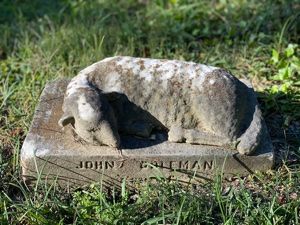
Lamb Lambs are symbols of innocence and the sacrifice of Jesus, the Lamb of God. They’re often on the graves of children.
Bodyparts

Eye illuminated in a pyramid This is the All-Seeing Eye of God or the Masonic Eye of Providence. The triangle is a symbol for the Trinity. This started appearing on the tombstones of Masons about 1800. This is similar to the Great Seal of the US that predates the Masonic use. Odd Fellows also use the All-Seeing Eye above the three-link chain.
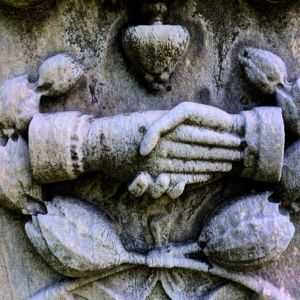
Handshake This was a common theme in the late 1800s usually for a marriage that’s lasted into the afterlife. The hand on the left often has a female cuff, is passive and open. The hand on the right typically has a male cuff, three fingers gripping and the index finger straight or unseen and touching his wife’s wrist. It’s also said to mean a welcoming into Heaven by the spouse that passed first. If the hand on the right has the index finger pointing downward, it can indicate the male was a member of thew Odd Fellows.
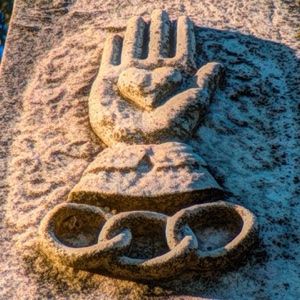
Hand with heart and three chain links This is a common symbol for the International Order of Odd Fellows. It is sometimes accompanied by an all-seeing eye and FLT inside the chain links.

Crossed arms are a Catholic sign of humility. When a cross appears above them, it’s the symbol of St. Francis. Usually one arm (sleeved) symbolizes prayer and the other, (sleeve rolled up) symbolizes hard work. This photo shows the stigmata (pierced hands) which St. Francis supposedly bore after a vision for the last two years of his life.
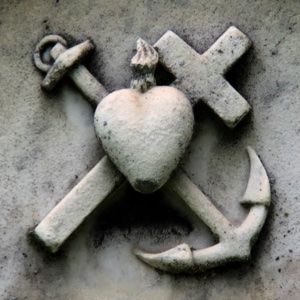
Heart: Sacred, immaculate or crossed and anchored Hearts are often associated with Catholicism. A heart with a flame atop is the Sacred Heart of Jesus. A heart with a sword piercing it is the Immaculate Heart of Mary. The heart with a cross and anchor are the three virtues: faith (cross), love (heart) and hope (anchor). The later became popular in the late 1600’s.
Numbers.
Numbers can have religious, fraternal or societal significance. Or they can just as easily be the style of the stone carver.
2.
- Marriage
- Twins
3.
- Three links to a chain. This is common on the grave of a member of the Odd Fellows.
- Three women are often Faith Hope and Charity.
- Trinity
5.
- Pentagram. When upside down it’s commonly for the Order of Eastern Star.
6.
- Star points on the Star of David or Seal of Solomon.
7.
- Biblical significance, since seven is the most popular number in the book and associated with mystic powers.
32 or 33.
These are the highest Masonic degrees.
Objects and symbols.
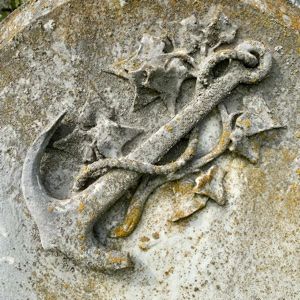
Anchor Anchors are popular on the graves of mothers, literally being the anchor of the family.

Book Most commonly it’s the Bible and was popular through the mid-1800s

Coins placed on tombstones While the Greeks placed a coin in the mouth of the deceased as Charon’s obol (1/6th of a drachma payment for the ferryman to Hades) and Vietnam vets started the trend of placing varying coins on graves depending on how close they served to the fallen comrade, the practice of placing a coin on a tombstone seems to be a simple matter of paying respect. You’ll often see them on the graves of children as a sign they have not been forgotten.
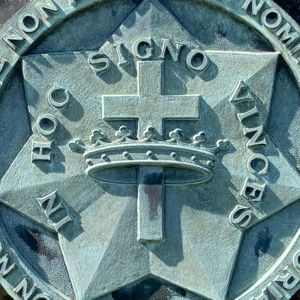
Cross in a crown This may not be a symbol for “Christ is King” as you’d think. It’s also used by the Knights Templar in York Rite, which is affiliated with the Masons.

Cup, grail, chalice or goblet It can mean the cup of life or absolved of sin.

Lyre or Harp Lyres are associated with Apollo and King David. A broken string is a symbol for breaking of the mortal coil. The number of strings may or may not have significance, but are commonly three to seven. Harps are symbols of hope and associated with the Odd Fellows, Masons and Ancient Order to Hibernians. A lyre may also used on the grave of a musician.
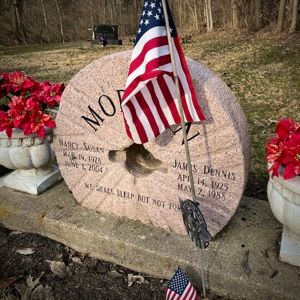
Millstone. This is associated with Quakers, who often owned and worked the local grain mill. Some stones are symbolic and cut from granite, while others are actual retired millstones.
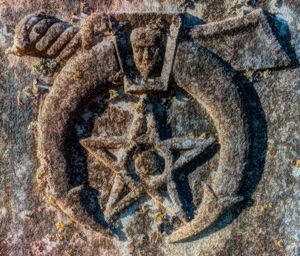
Scimitar, crescent and star This is the symbol for the Shriners, an offshoot of the Masons. To wear a fez and drive a go-cart require a high Masonic rank.

Sword with Clan Gunn crest Clan Gunn is one of the oldest Highland clans in Scotland, descended from the Norse Jarls of Orkney Island. Aut pax aut bellum means Either peace or war.

Inverted torch This is the symbol for a flame extinguished in life but burning on in the afterlife.
People and Personifications.

Angel of Grief Credit is given to sculptor William Wetmore Story for sculpting the original Angel of Grief in 1894 in honor of his late wife. He said it represents the abandoned prostration he felt. It’s one of the most copied graveyard sculptures. Commonly thought to represent an untimely death, that’s not the case with the original sculpture, since Emelyn Story died at age 75.
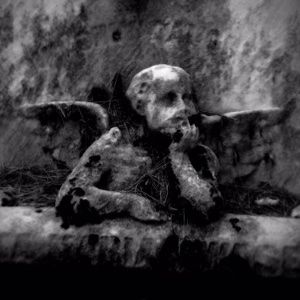
Cherubs in sorrow I commonly refer to these as bored angels. They’re often thought to be lamenting loss, especially of a child. It may also signify waiting for parents to join the deceased child in heaven.
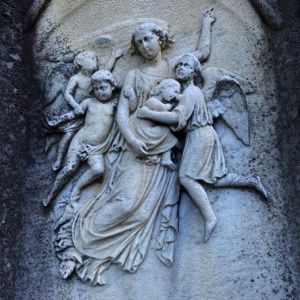
Angels with humans This means being taken up to heaven, as on this stone of a family that lost four children, all before the age of 10.

Baby With less advanced medical technology in the 1800s, the death of an infant was extremely common. First borns often warranted adorned graves.

Faith, Hope and Charity The three virtues of Christianity from Corinthians 1:13.
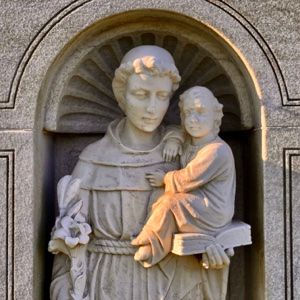
Saint Anthony of Padua Recognized by his tonsured haircut (bald on top, in imitation of Apostles James and Paul). Since the 1600s, St. Anthony (a Franciscan friar) is commonly seen holding the baby Jesus. He may also be holding a the Bible, bread or a lilly. St. Anthony is the patron saint of the illiterate, the poor and of lost things.
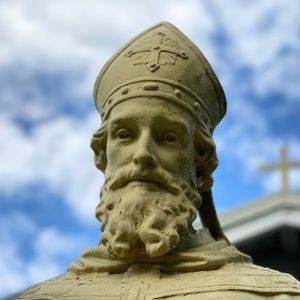
Saint Patrick Saint Patrick is the patron saint of Ireland. He’s often seen with a shamrock, which he used to explain how the Father, Son and Holy Ghost are one.
Plants
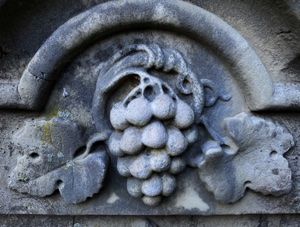
Grapes A bunch of grapes could mean many things:
- since the Greeks, it’s been the symbol of a bountiful life or
- fertility, parent of many children
- wine, the symbol of the blood of Christ
- a soul ready for harvest
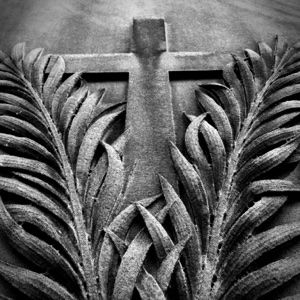
Palm frond Palm fronds were given to victors in Ancient Rome. They were laid as a path for Jesus to walk as he entered Jerusalem. On a grave, they symbolize victory over death.
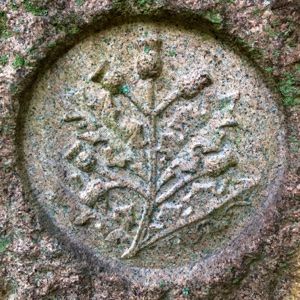
Thistle Thistles can have a few meanings. If biblical, they mean eternal sorrow. They’re the national flower of Scotland, They’re also an annual, a symbol for rebirth. You’ll see them on many older stones since they were once venerated as a flower and not vilified as a weed.
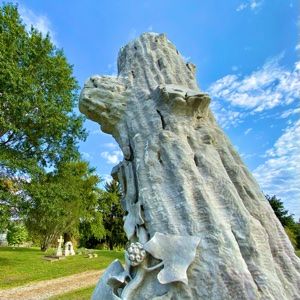
Tree stump, trunk or log Tree stumps were popular from the min 1800s until 1920. They were originally used to signify a life cut short, often over the grave of the father of the family. Sometimes the height of the stump signifies the height of the deceased, so a shorter stump may signify a child is buried there. Between 1900 and 1920 the stumps were adopted by two fraternal groups: Woodmen of the World and Modern American Woodmen. Woodmen graves may also have woodworking tools like axes and saws.
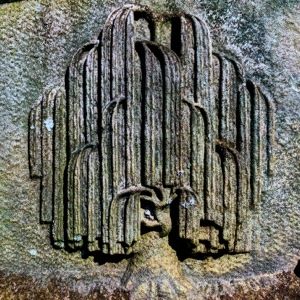
Weeping willow This was popular on tombstones in the early and mid 1800s. While the willow can symbolize grief, it can also mean long life, resurrection and immortality.
Geometry and Shapes.
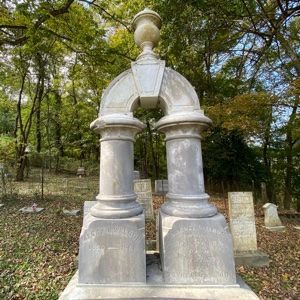
Rounded arch These were popular in the 1800s and usually represent the matrimonial bond between a husband and wive buried below.
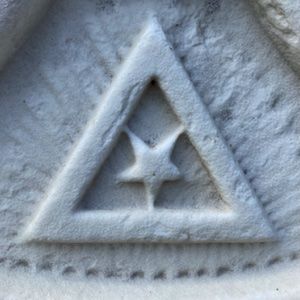
Star: Upside down pentagram Sometimes associated with Satan today, on a gravestone it typically signifies Order of the Eastern Star, an offshoot of the Masons.
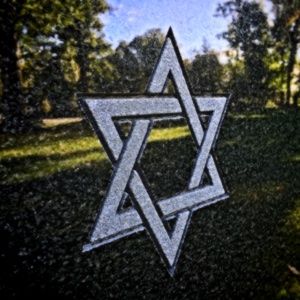
Star: Star of David and Seal of Solomon In more modern times both are formed by two equilateral triangles placed pointing up and down to create a six-pointed star. The Star of David has connected triangles and the Seal of Solomon has interlocking triangles, as in the image. The original seal on Solomon’s (David’s son’s) ring likely was a five-sided star, possibly pointing down, and was said to give him power over demons. Both the five and six-pointed shapes have been commonly used in mysticism and ceremonial magic by many organizations over the years including Jewish, Christian, Islamic and pagan. The symbol is often seen on the graves of Jewish males and gained popularity in the 1900s. If other symbols are present, the person may be linked with a secret society.
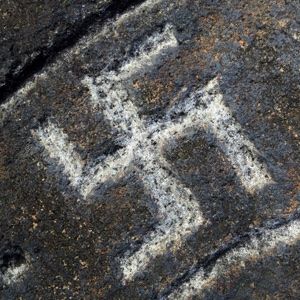
Swastika The Nazi Party in Germany trashed the reputation of this symbol in 1933 and seems to have cursed it forever. Previous to that, it was used in many cultures, including Trojan, Hindu and Native American. Swastika is a Sanskrit word meaning “good fortune”. It was considered a good luck charm for early aviators and used by the Theosophical Society. It gained worldwide popularity from about 1880 until 1920. The one above appears on the Icelandic-carved, runic gravestone of Arthur Middleton Reeves, who died in 1891 when Hitler was two years old. Reeves, an American Quaker, proposed Icelanders arrived in the new world 500 years before Columbus, which was proven true in 1960.

Triangle The equilateral triangle pointing up is commonly a symbol for God. This one contains an all-seeing eye, common on Masonic graves.
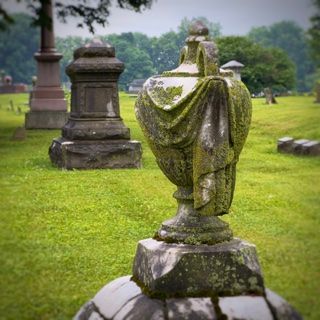
Urn Urns started appearing on tombstones in the 1800s and remain a common cemetery fixture. Though cremation wasn’t popular back then, the urn has its roots in Roman and Greek times when bodies were commonly cremated. Urns can be partially draped, representing the transition or gateway from the here to hereafter.
Terms and Acronyms.

- A and Ω︎ Alpha and Omega are the first and last letters of the Greek Alphabet. They signify the quote attributed to Jesus: I am Alpha and Omega. In addition to the one birthed there being a Christian, this can mean the beginning and end of life.
- Christos Sit Regula Vitae “May Christ be the rule of life.” The person buried there supposedly did as Jesus did.
- Consort of. It can mean a husband, wife or companion. It was common on stones in the 1800s of a wife when the husband survived her.
- Deue Muemque Jus. God and my right. Associated with the 33rd Masonic degree.
- Dum Tacet Clamat Though silent, he speaks. On the tombstones of Woodmen of the World.
- FCB. Friendship, Charity, Benevolence is a slogan of the Knights of Pythias.
- FLT Motto of the Independent Order of Odd Fellows: Friendship Love Truth. This often appears inside three chain links.
- Fugit Hora Latin for “Time flies”.
- Geb-Gest. In German, geboren means born and gestorben means died.
- Heir Ruhet or Heir Ruht. It’s German for here rests.
- HTWSSTKS “Hiram Tyrion Widow’s Son Sent to King Solomon” Nope, not a nursery rhyme. Related to Royal Arch, part of the Masonic York Rite.
- IHS Iesus Hominum Salvator is Latin for Jesus, Savior of Mankind. Often the letters are seen interlocking.
- In Alter German for in old age or at the age of.
- In Hoc Signo Vinces In this sign you shall conquer. A Knights Templar (Masonic) slogan, often seen with a cross and crown.
- INRI The Latin Iesus Nazarenus, Rex Iudaeorum means Jesus the Nazarene King of the Jews.
- LOOM Loyal Order of Moose.
- Momento Mori Latin for “Remember: You must die”.
- MWA or WOW The Modern Woodmen of America (now referred to just as Modern Woodmen) and Woodmen of the World (now WoodmanLife) are nonprofits that serve as both fraternal societies and a life insurance/investment companies for members. Both orders were founded Joseph Root in 1883 and 1890 and designed to provide for families, should the breadwinner die. Root was ousted from MWA and founded WOW on the same principles. Membership was originally restricted to healthy white males 18-45. They could be a follower of any of the commonly-accepted western religions, agnostic or atheist. Symbols commonly include axes and stumps.
- Non Nobis Sed Nomini Tuo Da Gloriam Not to us Lord, but to your name give glory. A motto of the Knights Templar and later Masons. The full version is Psalm 113:9 ”Non nobis domine. Non nobis sed nomini. Tuo da gloriam.” Not unto us, O Lord, not unto us, but to thy name give the glory.
- PAX Latin for “peace”.

- Reversed letters N, S and Z are the most common reversed letters on tombstones. It’s likely that this was not symbolic or even intentional. Capital N, S and Z are three of the most commonly confused letters for dyslexics. It’s most likely the stone carver was illiterate.
- Sacred to the memory of This was very popular on stones through about 1850. Essentially it means “this sacred ground dedicated too”
- Spectemur Agendo Latin for Let us be judged by our acts.
- Spes Mea In Deo Est Latin slogan for Scottish Rite of Masonry meaning My hope is in God.
- Starb Am German for died on.
- WCTU Women’s Christian Temperance Union. Often accompanied by an archer’s bow.
- XP Chi (X) and Rho (P) are the first two letters in Greek spelling of Christ. The symbol is associated with Emperor Constantine, the first Christian emperor of Rome, who put it on shield of his soldiers.

You’ll find more in my article Dying in America.
This growing article is based on my own finds and photos, so it strongly favors symbols seen on tombstones from 1800 in the Midwest US. If you find it useful, please consider buying me a coffee below to help support its growth.
